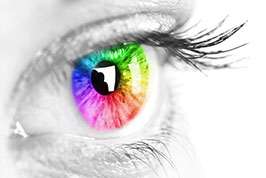Percieving Color Blindness


Not the most serious disability, color blindness or the inability to differentiate between various colors, is the result of a visual disorder that occurs due to the absence of specific cells
Color blindness, also known as Color Vision Deficiency (CVD), is when an individual has trouble detecting color or differentiating between colors under normal light settings. There is no actual blindness involved, rather it is more of a deficiency in color vision. Amazingly, this condition is gender biased.
Yes! Color blindness is generally seen more in males than in females because the gene responsible is carried on the X chromosome which men have only one, compared to women who have two X chromosomes. Since females have two of the X chromosomes, the chances of a functional gene are higher.
What Are The Symptoms?
One of the obvious symptoms of this condition is that the affected individual is likely to find it difficult to identify the different colors.
However, in spite of the condition becoming increasingly common, in most cases it often goes unnoticed unless the affected individual is tested in a professional lab. In severe cases, the deficiency can affect sharpness of vision.
Why Does It Occur
In the eye, the retina is a lining of light sensitive tissue in the back where two types of cells that detect light are found – rods and cones. Rods detect only light and darkness and work well in low light levels.
Cone cells detect the actual color and are concentrated near the center of one’s vision. There are three types of cones that see color: red, green and blue. The brain uses these three color cone cells to determine the actual color perception.
Color blindness occurs when one or more of the color cone cells are absent, non-functioning or detect a different color than normal.
Inherited Color Vision Deficiency or color blindness can also be passed on genetically. If color vision problems surface later in life, they are a result of disease, trauma from injury, toxic effect from drugs, metabolic disease or vascular disease.
In such cases, the condition is also known as acquired color blindness. Disease-specific color blindness often affects both eyes differently, and the defect usually worsens over time.
Diagnosing Color Blindness
Detecting congenital color blindness can be difficult in young children particularly as they may be unaware of the symptoms that they are experiencing. The best option is to teach children to identify colors starting at a young age.
Additionally, eye checkups with an optometrist will normally consist of color vision tests on routine basis, so the deficiency can be detected easily. Other times, individuals may have to request specifically for the color vision test. Also, if there is any discomfort detected in vision, a general practitioner can also examine for the symptoms of color deficiency. When it comes to detection methods, there are various options.
Being Color Blind
A color blind person, even though not blind completely, can find difficulties in day-to-day life as against a person having a normal vision. Simple activities like choosing and preparing food, gardening, driving a car, shopping, etc. get affected due to the inability to differentiate between colors.
Treatments
Currently, there are no treatments for congenital color blindness and usually it does not cause any significant disability. Special contact lenses and glasses are also available that are known to help people with color blindness to differentiate between similar colors.
Types Of Color Blindness
A normal vision will have all the three types of light cones functioning well, known as trichromacy. In color blindness, the degrees of vision deficiency can be summed up in three types and further in depth dimensions of each:
Anomalous trichromacy is a common type where the individual will be color blind just to some extent and this occurs when one of the three cone pigments is altered in its spectral sensitivity.
Dichromacy is when only two types of the cones are able to perceive color, that means there is total absence in the functioning of one cone type.
Monochromacy is where an individual cannot see any color at all, thus their vision consists only of different shades of grey like watching on an old black and white television set.
This article has been written with inputs from Dr Naseem Fakhereddeen (Specialist Ophthalmic Surgeon, iCare Clinics)
Source:http://youandeyemag.fourplusmedia.com/percieving-color-blindness/